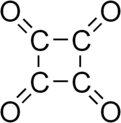This is an old revision of this page, as edited by Citation bot (talk | contribs) at 00:28, 12 October 2021 (Alter: title. Add: bibcode, pmid, authors 1-5. Removed parameters. Some additions/deletions were parameter name changes. | Use this bot. Report bugs. | Suggested by Abductive | Category:Hypothetical chemical compounds | #UCB_Category 21/71). The present address (URL) is a permanent link to this revision, which may differ significantly from the current revision.
Revision as of 00:28, 12 October 2021 by Citation bot (talk | contribs) (Alter: title. Add: bibcode, pmid, authors 1-5. Removed parameters. Some additions/deletions were parameter name changes. | Use this bot. Report bugs. | Suggested by Abductive | Category:Hypothetical chemical compounds | #UCB_Category 21/71)(diff) ← Previous revision | Latest revision (diff) | Newer revision → (diff)
| |

| |
| Names | |
|---|---|
| IUPAC name Cyclobutane-1,2,3,4-tetraone | |
| Other names Tetraoxocyclobutane | |
| Identifiers | |
| CAS Number | |
| 3D model (JSmol) | |
| ChemSpider | |
| PubChem CID | |
| CompTox Dashboard (EPA) | |
InChI
| |
SMILES
| |
| Properties | |
| Chemical formula | C4O4 |
| Molar mass | 112.040 g·mol |
| Except where otherwise noted, data are given for materials in their standard state (at 25 °C , 100 kPa).
| |
Cyclobutanetetrone, also called tetraoxocyclobutane, is an organic compound with formula C4O4 or (CO)4, the fourfold ketone of cyclobutane. It would be an oxide of carbon, indeed a tetramer of carbon monoxide.
The compound seems to be thermodynamically unstable. As of 2000, it had yet to be synthesized in significant amounts but may have transient existence as detected by mass spectrometry.
Related compounds
Cyclobutanetetrone can be viewed as the neutral counterpart of the squarate anion C
4O
4, which is stable and has been known at least since 1959.
The compound octahydroxycyclobutane or cyclobutaneoctaol (C(OH)2)4 may be referred to in the literature as "hydrated tetraoxocyclobutane".
References
- Guo, J.-C.; Hou, G.-L.; Li, S.-D.; Wang, X.-B. (2012). "Probing the Low-Lying Electronic States of Cyclobutanetetraone (C4O4) and Its Radical Anion: A Low-Temperature Anion Photoelectron Spectroscopic Approach". Journal of Physical Chemistry A. 3 (3): 304–308. doi:10.1021/jz201593z. PMID 26285843.
- Jiao, H.; Frapper, G.; Halet, J.-F.; Saillard, J.-Y. (2001). "Stability of Tetraoxocyclobutane Revised: Perturbation Theory and Density Functional Scheme". Journal of Physical Chemistry Letters. 105 (24): 5945–5947. Bibcode:2001JPCA..105.5945J. doi:10.1021/jp010738i.
- Rubin, M. B.; Gleiter, R. (2000). "The Chemistry of Vicinal Polycarbonyl Compounds". Chemical Reviews. 100 (3): 1121–1164. doi:10.1021/cr960079j. PMID 11749259.
- Seitz, G.; Imming, P. (1992). "Oxocarbons and pseudooxocarbons". Chemical Reviews. 92 (6): 1227–1260. doi:10.1021/cr00014a004.
- Schröder, D.; Schwarz, H.; Dua, S.; Blanksby, S. J.; Bowie, J. H. (1999). "Mass spectrometric studies of the oxocarbons CnOn (n = 3–6)". International Journal of Mass Spectrometry. 188 (1–2): 17–25. Bibcode:1999IJMSp.188...17S. doi:10.1016/S1387-3806(98)14208-2.
- Cohen, S.; Lacher, J. R.; Park, J. D. (1959). "Diketocyclobutanediol". Journal of the American Chemical Society. 81 (13): 3480. doi:10.1021/ja01522a083.
- Skujins, S.; Delderfield, J.; Webb, G. A. (1967). "A mass spectrometric study of some monocyclic polycarbonyl compounds". Tetrahedron. 24 (13): 4805–4817. doi:10.1016/S0040-4020(01)98676-4.
- Maahs, G.; Hegenberg, P. (2003). "Syntheses and Derivatives of Squaric Acid". Angewandte Chemie International Edition. 5 (10): 888–893. doi:10.1002/anie.196608881.
See also
| Oxocarbons | |
|---|---|
| Common oxides | |
| Exotic oxides | |
| Polymers | |
| Compounds derived from oxides | |